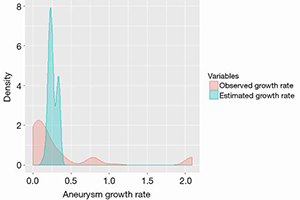Natural history of aortic root aneurysms in Marfan syndrome
Abstract
Background: Cardiovascular complications account for a significant proportion of the shortened lifespan of Marfan syndrome (MFS) patients, with aortic dissection being the most dreadful complication. The aortic root dilates initially in MFS patients, and given its important hemodynamic role, this can lead to aortic regurgitation and poses a substantial risk of aortic dissection. This study seeks to evaluate the natural history of aortic root aneurysms in MFS patients, with a focus on growth rates and correlation of root diameter with the risk of developing aortic complications.
Methods: Seventy-eight patients confirmed to have MFS and aortic root dilatation were retrospectively reviewed, and their aortic root diameters serially analyzed. Annual growth rate estimates and yearly rates of adverse events were computed and correlated with aortic diameter.
Results: The mean annual growth rate of the aortic root was estimated to be 0.26±0.05 cm/year (range 0.13 to 0.35 cm). Larger aneurysms grew faster, reaching up to 0.46 cm/year for aneurysms >6 cm. Mean age at onset of aortic dissection was 36±4 years. Annual rates of adverse events (rupture, dissection and death) were obtained using a logistic regression model at sizes 3.5, 4, 4.5, 5, 5.5 and 6 cm. A sharp increase of 23% in the probability of the risk of complications at diameters 5.5 to 6 cm was recognized.
Conclusions: Aortic root aneurysms in MFS patients tend to have a faster expansion rate compared to non-MFS individuals, with aortic root diameter having a significant impact on the yearly risk of developing aortic complications.
Cover






